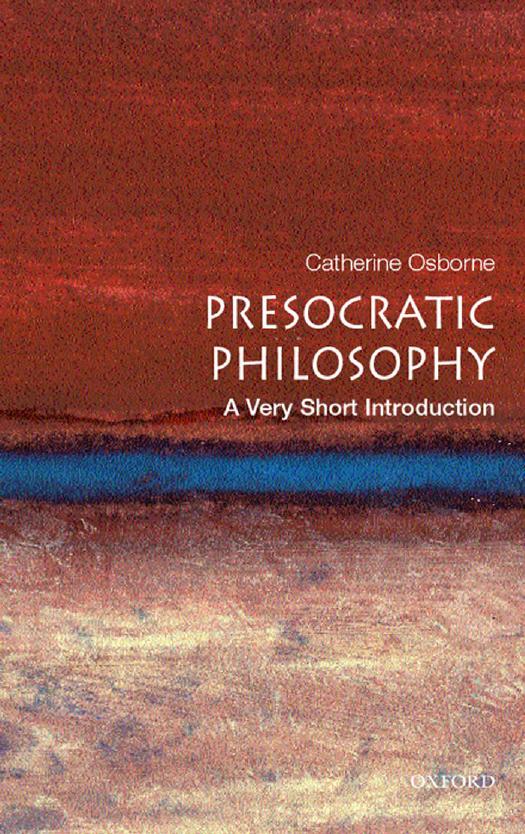Presocratic Philosophy: A Very Short Introduction by Catherine Osborne

Author:Catherine Osborne [Osborne, Catherine]
Language: eng
Format: epub, pdf
Tags: Philosophy, History & Surveys, Ancient & Classical
ISBN: 9780192840943
Google: F-oRDAAAQBAJ
Publisher: OUP Oxford
Published: 2004-04-22T19:01:50.516279+00:00
yh
ilosoph
atic P
Presocr
18. Democritus became known to later tradition as the âlaughing philosopherâ, largely as a result of the circulation of apocryphal stories about his cheerful attitude to life and fortune, and his perception of the follies of other men.
same problems with explaining the reactions between smaller and yet smaller bodies. There will be another appearance and reality divide at the next level down, and it will be necessary to appeal yet again to deeper phenomena to explain the apparent behaviour of the first set of hypothetical particles, and so on ad infinitum. Twenty-first century science meets the same difficulty. It continues 76
Democritus thinks that the nature of eternal things consists in small substances, infinite in quantity, and for them he posits a place, distinct from them and infinite in extent. He calls place by the names âvoidâ, ânothingâ and âinfiniteâ; and each of the substances he calls âthingâ, âsolidâ and âbeingâ. He thinks that the substances are so small that they escape our senses, and that they possess all sorts of forms and all sorts of shapes and differences in magnitude. . . . He explains how the substances remain together in terms of the way in which R
the bodies entangle with and get hold of one another; for ealit
some of them are uneven, some hooked, some concave, some y an
convex, and others have innumerable other differences. d a
p
Aristotle, On Democritus, from a quotation in pear
Simpliciusâs commentary on the De Caelo, 294, an
ce
tr. J. Barnes
: more a
Box 17: Democritus and the properties of atoms. What features dventures in m
does an individual atom have, as opposed to a collection of atoms?
e
to pursue quantum physics in the search for explanations of taph
phenomena at the atomic level, which were themselves intended ysics
to explain phenomena at the level of experience. But so long as the explanations remain of the same order as the phenomena to be explained (physics explained by physics, mathematics explained by mathematics), the same demand for explanation will simply emerge again at the next level. Democritusâs atoms provided inspiration to Robert Boyle and others when they rediscovered his ideas in the 17th century; but the atomic theory was destined never to escape from the dilemma of unending gaps in explanation.
Philosophy, meanwhile, had continued to probe the appearance and reality distinction for other riches.
77
Download
Presocratic Philosophy: A Very Short Introduction by Catherine Osborne.pdf
This site does not store any files on its server. We only index and link to content provided by other sites. Please contact the content providers to delete copyright contents if any and email us, we'll remove relevant links or contents immediately.
| Africa | Americas |
| Arctic & Antarctica | Asia |
| Australia & Oceania | Europe |
| Middle East | Russia |
| United States | World |
| Ancient Civilizations | Military |
| Historical Study & Educational Resources |
Machine Learning at Scale with H2O by Gregory Keys | David Whiting(4185)
Never by Ken Follett(3794)
Fairy Tale by Stephen King(3220)
The Man Who Died Twice by Richard Osman(2997)
Oathbringer (The Stormlight Archive, Book 3) by Brandon Sanderson(2888)
Will by Will Smith(2794)
Rationality by Steven Pinker(2291)
The Dark Hours by Michael Connelly(2245)
Can't Hurt Me: Master Your Mind and Defy the Odds - Clean Edition by David Goggins(2228)
The Dawn of Everything: A New History of Humanity by David Graeber & David Wengrow(2122)
Friends, Lovers, and the Big Terrible Thing by Matthew Perry(2119)
Principles for Dealing With the Changing World Order: Why Nations Succeed and Fail by Ray Dalio(1974)
HBR's 10 Must Reads 2022 by Harvard Business Review(1777)
A Short History of War by Jeremy Black(1762)
Go Tell the Bees That I Am Gone by Diana Gabaldon(1687)
515945210 by Unknown(1599)
A Game of Thrones (The Illustrated Edition) by George R. R. Martin(1590)
Kingdom of Ash by Maas Sarah J(1527)
443319537 by Unknown(1470)
